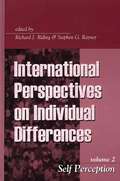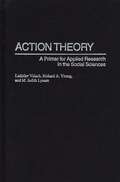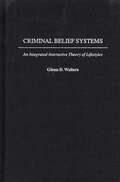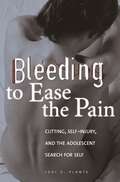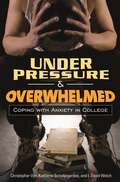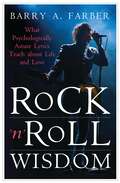- Table View
- List View
Intimate Violence against Women: When Spouses, Partners, or Lovers Attack (Women's Psychology)
by Paula K. Lundberg-Love Shelly L. MarmionEvery year, at least 1.8 million women in the United States are beaten by their intimate partners. And that is only the number reported physically abused. It does not include those who remain silent, or those for whom the abuse is psychological. In this concise work, a team of writers examines the emotional, physical, and sexual abuse of women, the risk factors for becoming a target, medical and psychological consequences, legal issues and effective treatments for recovery. The book dispels myths about intimate violence, including the notion that one can identify a potential perpetrator. The most current research, theory and advocacy on this topic are presented so the reader will have the knowledge to help herself or others who are being abused.Every year, at least 1.8 million women in the United States are beaten by their intimate partners. And that is only the number reported physically abused. It does not include those who remain silent, or those for whom the abuse is psychological.In this concise work, a team of writers examines the emotional, physical and sexual abuse of women. They explain the risk factors for becoming a target of intimate abuse, including the effects of class and culture on this type of violence. They look at the potential legal issues, and explore effective treatments for recovery. Equally important, they dispel many myths about intimate violence, including the notion that one can identify a potential perpetrator. Most crucially, Intimate Violence against Women offers current research, theory and advocacy on this topic, arming the reader to with the knowledge to help herself or others who are being abused. The book presents specific safety recommendations for victims, as well as recommendations for teen-agers regarding dating violence. Legal and advocacy resources are included as well.
Coping with Infuriating, Mean, Critical People: The Destructive Narcissistic Pattern
by Nina W. BrownFor all of us forced to deal with an infuriating, mean, critical person, seasoned counselor Nina Brown has a word of warning. You must accept that your usual coping strategies are not effective, and will not be effective, with this person, she advises. You cannot expect them to react and behave as adults. So what's a victim to do? Start with the suggestions in this book.In Coping with Infuriating, Mean, Critical People, Brown explains why many people, who may not display all of the characteristics necessary for a formal, full-blown narcissist diagnosis, still display what she calls a destructive narcissistic pattern that results in much the same anguish for those with whom the individual interacts. Thankfully, she also provides specific methods that will help victims of this behavior deal with the narcissistic colleague, supervisor or boss, parent, or intimate other.Only the extremely lucky among us have never faced or felt the effects of narcissistic behaviors and attitudes, displayed by colleagues, bosses, friends, parents, or lovers. These individuals may boast and brag constantly, take credit for other people's work, expect favors but return few or none, never listen (but always know all the answers), be sure of what is right and best regardless of the topic. They devalue others, micromanage, are hypercritical and mistrustful. Other characteristics of this harmful personality include an inflated sense of importance, although achievements are exaggerated and actual outcomes don't support feelings of superiority. They are exploitative, without empathy, and believe they are envied by all. Brown's excellent advice will help you cope.
The Self-Sabotage Cycle: Why We Repeat Behaviors That Create Hardships and Ruin Relationships
by Stanley Rosner Patricia HermesA 12-year-old boy vows he will never do to his future family what his father did by leaving the boy, his sister and mother. Yet, 30 years later, the boy now a man leaves his own family. A young woman who's broken off an abusive relationship is now attracted to the same kind of personality in a potential boyfriend. And an attorney who grew up with an impossible-to-please father takes a job in a firm where the boss thinks praise is never productive. These are the kind of repetitive cycles that Stanley Rosner has seen time and again in his practice across 40 years as a clinical psychologist. A past president of the Connecticut Psychological Association, Rosner examines in this book whether there is for some people a compulsion to repeat self-destructive acts, and what the foundation for that compulsion might be, as well as how it can be changed to afford better, happier living.Assisted by popular author Patricia Hermes, Rosner offers many eye-opening vignettes from his therapy rooms, showing us clearly how early life events can create unconscious dilemmas that move us to repeat the situation in other forms. He aims to show us how we can resolve the issues that linger, explaining how to recognize these issues, then move forward to put them to rest in ways that are not self-sabotaging. What I have to offer, says Rosner, is the opportunity for change.
Planting Hatred, Sowing Pain: The Psychology of the Israeli-Palestinian Conflict
by Moises F. SalinasAs renewed hatred pumped the people of Israel and Palestine in summer 2006 fueling a flurry of bombings, kidnappings, and murders, author Moises Salinas continued research and interviews for this book in those nations. In Planting Hatred, Sowing Pain, the psychology professor explains why it often seems this conflict that has been raging more than 70 years is illogical. While in recent years both groups have basically agreed on the broad parameters of a peace agreement, the fight still continues. Salinas argues that the obstacles to achieving a solution are not just political, but also psychological. He shows that just as disagreements over borders, refugees, and settlements keep the parties from the negotiating table, so do psychological factors including mistrust, hatred, stereotypes, and prejudice.The world has known many periods when two factions manifested such strong hatred of each other that bloody conflicts were regular, ongoing, unsurprising events. But there is perhaps no modern conflict as sustained as that of the ongoing Israel-Palestine conflict. Through interviewees ranging from an Israeli right-wing settler and a Palestinian militant to commoners on both sides who were simply victims of violence, Salinas shows how the hatred and mistrust were created and why they persist. The book includes compelling reviews of the psychological research regarding Israeli-Palestinian relationships and of stereotype and prejudice formation, violence and dehumanization, post-traumatic stress, as well as reconciliation, mediation, and peacemaking. An appendix provides the Geneva Accord model of an Israeli-Palestinian Peace agreement.
Cultural Guidance in the Development of the Human Mind (Advances in Child Development Within Culturally Structured Environments)
by Aaro ToomelaThis volume is unique in integrating different domains of psychology, at both theoretical and empirical levels of analysis, in order to understand the development of the human mind. Perspectives include comparative, cultural, and developmental psychology, in addition to neuropsychology. Contributors in this edited collection emphasize both the collective nature of human cognition and the impossibility of separating individuals from their sociocultural environments. They also explain how participation in culture leads to radical changes in an individual's psychological makeup. This volume may also be of interest to anthropologists, philosophy scholars, and semioticians.Major topics include:• Human Development from the Perspective of Comparative Psychology• Culture in the Developing or Regressing Brain• Cultural Perspective on the Human Development• The Role of Culture in Child Development
The Psychology of Death in Fantasy and History (Non-ser.)
by Jerry PivenThis volume investigates the impact of death consideration on such phenomena as Buddhist cosmology, the poetry of Rilke, cults and apocalyptic dreams, Japanese mythology, creativity, and even psychotherapy. Death is seen as a critical motivation for the genesis of artistic creations and monuments, of belief systems, fantasies, delusions and numerous pathological syndromes. Culture itself may be understood as the innumerable ways that societies defend themselves against helplessness and annihilation, how they mould and recreate the world in accordance with their wishes and anxieties, the social mechanisms employed to deny annihilation and death. Whether one speaks of the construction of massive burial tombs, magical transformations of death into eternal life, afterlives or resurrections, the need to cope with death and deny its terror and effect are the sine qua non of religion, culture, ideology, and belief systems in general.
The Life and Behavior of Living Organisms: A General Theory
by Elliott JaquesJaques presents a totally new general theoretical foundation for understanding the individual and social behavior of all living organisms. In contrast to existing theories of behavior which are static, Jaques has succeeded in breaking through to a truly dynamic orientation. This breakthrough, resulted from his fundamental research into work organizations that led to the realization that the difference between inanimate processes and all living behavior, is that all living behavior is composed of intentional goal-directed work.This continuous work entails the use of judgment in choosing goals and in making the decisions necessary to get to these goals. This work process is the same in all living organisms, including humans. It is an ineffable process of the total organism, inaccessible to direct observation and experience. Intentionality is the dynamic of behavior. This discovery has led over the past 50 years to extensive discoveries--objective measures of work complexity, and of the level of complexity (capability) of individuals in all species; how human language differs from communication in other species; the need to distinguish between horizontal evolutionary mutations within a given level of capability, and vertical evolution to species with higher levels of complexity; the nature of freedom within mutual-trust inducing constraints. Set forth to radically change the nature of all behavioral and social sciences in the new millenium, Jaques' analysis is essential reading for all scholars, students, and researchers as well as the general public involved with the behavior of living organisms.
Ethnic Times: Exploring Ethnonationalism in the Former Yugoslavia
by Dusan KecmanovicKecmanovic deals with the phenomenon of ethnonationalism, both as a broad, worldwide concern and as a key ingredient to the struggles in the former Yugoslavia. As in the former Yugoslavia, the rise of ethnonationalistic sentiments and attitudes coincided with the transition from a state-and party-run affair to a new, post-communist type of government and society. Drawing upon his personal experiences in Sarajevo, Kecmanovic provides a unique view of the conflict.In a style accessible to students and general readers, he traces the transformations of leading principles, value systems, behavioral patterns, and views of people in times of severe ethnic tensions. At times nearly novelistic, the book examines epidemic ethnonationalism and individual manifestations such as violence toward members of other groups, beliefs that ethnic differences are genetic, a need to aggrandize and even manufacture differences between communities.
Hypnotic Leadership: Leaders, Followers, and the Loss of Self (Non-ser.)
by Micha PopperCharismatic leadership in its extreme manifestations resembles a hypnotic situation in which the followers lose their autonomic judgment. Popper compares leadership to fire. The leader is the spark, the followers the fuel, and the circumstances the oxygen that feeds the flames. Fire can destroy everything in its path, and such a strong fire is a metaphor for what is described as Hypnotic Leadership.Describing examples of hypnotic leadership and using theories and concepts from psychology and the social sciences, Dr. Popper begins by providing three examples of leaders defined as hypnotic, whose spheres of influence ranged from a small group to millions of people. He then looks at the object of the hypnotism, the followers, demonstrating the psychological meaning of the yearning for a leader. While describing this as a possible general condition, Popper qualifies the universality of the argument, referring to differences between cultures in the attitudes toward authority or the ability to tolerate ambiguity. These differences are of great significance in terms of the susceptibility of being hypnotized by a charismatic leader. Popper then examines the meeting of factors that create the drama of hypnotic leadership, presenting the central concepts that are used in analyzing the phenomenon, and demonstrating their use with reference to examples cited and the analysis of the processes in a broad perspective. This is a provocative analysis for students and scholars of leadership and psycho-dynamic processes.
Self Perception (International Perspectives on Individual Differences)
by R. J. Riding Stephen RaynerThe second book in a new seies, Self Perception brings together contemporary perspectives on individual differences in psychology. Drawing upon an international field of established and new researchers, the series presents both theoretical and applied work looking at individual difference in human performance. The re-appraisal of self perception is considered as part of the development of new thinking in the theory of self-reference. This includes models of self from the United States and the United Kingdom.The book goes on to explore recent research from around the globe. Not only are studies from Australia, Norway, and the United States examined but research from Greece and Kuwait is also explored. Varied topics are covered, including the effects of gender, self-esteem, and pupil self-perception in the academic context. Set within the framework of a conceptual synthesis of the research, the book offers a contemporary review of current thinking in the field. The contributors provide recent, relevant, and alternative perspectives for psychologists and applied scientists.
The Age of Insanity: Modernity and Mental Health
by John F. SchumakerThe often misunderstood modern person syndrome is a disorder linked to the conditions of living in our contemporary society. The author argues that the conditions of modernity have introduced new processes, forces, and cultural motivations that have major implications for all aspects of mental health and social well being. While modernity offers unprecedented opportunities for personal enhancement and creative expression, there is mounting evidence of a mental health crisis that demands the immediate attention of mental health professionals. In order to address the new challenges that have arisen under conditions of modernity, mental health professionals must rethink fundamental assumptions about the relationship between society and mental health, as well as the impact of modern social concerns upon individual behavior and psychological well being.This innovative approach to mental health seeks to explain a variety of psychological trends, including the steep rise in depression, the sharp increase in the prevalence of existential disorders, and the emergence of consumption disorders. By shedding light on the interaction between modernity and mental health, Schumaker illuminates the emerging patterns of mental disturbance while also offering new and more effective intervention and prevention strategies.
Drug Problems: Cross-Cultural Policy and Program Development (Non-ser.)
by Richard Isralowitz Richard Rawson Mohamed AfifiSubstance abuse and its social consequences are a major public concern for communities throughout the world. The motivations and consequences are deeply imbedded within the social and political structures of all countries, whether they be well-established democracies or developing nations.Every culture shapes the meaning of and responses to substances such as marijuana and heroin over time and across locations, but the broader drug issue has become universal. As the sphere of the problem expands, the experiences and solutions of each nation become more relevant to other countries. International concern over substance abuse has intensified as a result of the rise in production, use, and trafficking of illicit drugs all over the world. Therefore, the practical knowledge of policy development and abuse prevention and treatment strategies in the Middle East have increasing relevance for the rest of the world.
The Drug Problem: A New View Using the General Semantics Approach (Non-ser.)
by Martin LevinsonCurrent approaches to the drug problem are not working and almost everyone agrees that more effective solutions are needed. This comprehensive volume offers a dynamic new approach to understanding and solving the drug problem. This text applies the techniques and formulations of general semantics to investigate and make recommendations about various aspects of drug abuse. General semantics, a process problem-solving approach based on the primacy of the scientific method and importance of language as a shaper of thoughts and perceptions, has a proven record of success in problem-solving across a wide variety of disciplines and fields.Topics examined include American drug history and policy, the legalization issue, drugs and creativity, treatment, and prevention. A chronological overview of drug-taking in human history and a resource guide are provided. One chapter offers an in-depth description of an effective drug abuse prevention model and a program using the model.
Action Theory: A Primer for Applied Research in the Social Sciences (Non-ser.)
by Ladislav Valach Richard A. Young M. Judith LynamThe authors describe a view that our short-, medium-, and long- term behavior, interactions, and relationships—whether planned or spontaneous, purposeful or playful—can be understood in terms of goal-directed systems. An understanding of action theory and research methods used in applied settings is provided. It leads to the conclusion that individual processes are joint processes and the joint construction of lives should be monitored to understand ongoing personal and social involvements.The unique contribution of this book lies in its bringing together and extending of basic features of the theory of goal-directed action systems previously published in a range of scattered research and conceptual articles in the literature. Professionals including clinicians, counselors, social workers, researchers, doctors, nurses, and physical or occupational therapists will find in this book an accessible means to understand, act on, research, and intervene in the behavioral processes they encounter in everyday work.
Criminal Belief Systems: An Integrated-Interactive Theory of Lifestyles (Non-ser.)
by Glenn D. WaltersWalters integrates information from traditional criminological models and findings from developmental psychology to form a system of five belief systems (self-view, world-view, past-view, present-view, and future-view) designed to explain crime initiation and maintenance. While reviewing belief systems that support crime, Walters also offers a model of change through which belief systems incongruent with crime can be constructed.He begins with a review of six traditional criminological models, each of which is considered to possess sufficient breadth and substance to advance our understanding of crime. Information gathered from these major theoretical systems is integrated wtih research from developmental psychology to create a system of crime-congruent belief systems. The belief systems, along with recent research on attributions, outcome expectancies, efficacy expectancies, values, goals, and thinking styles, are then used to construct a general theroy of crime and explain four specific categories of crime: violent crime, sexual assault, white-collar crime, and drug tafficking. Walters concludes with a model of assisted change whereby belief systems incongruent with crime are initiated and maintained with the intent of helping people abandon crime-congruent lifestyles. This change model revolves around four core elements—responsibility, confidence, meaning, community—each of which is emphasized in a clinician's interactions with clients seeking to abandon crime-congruent lifestyles. As Walters maintains, belief systems are instrumental in both the development and cessation of crime-congruent lifestyles. Of particular interest to scholars, students, researchers, and practitioners involved with criminology, criminal justice, and clinical and correctional psychology.
Learning from Behavior: How to Understand and Help Challenging Children in School (Child Psychology and Mental Health)
by James E. LevineLevine shows us how to observe, question, and think about children's problem behaviors in school from the child's perspective so we can understand what is motivating children to act as they do before we intervene. Cases included in this book range from noncompliance and poor academic performance to disinhibition, suspected ADHD, PTSD, and injury-caused acting out.Understanding children's problem behaviors in school— seeing beyond the surface actions to reveal and name the root needs fueling those actions—is vital to helping the child. Yet, whether teachers in schools or parents at home, adults often make quick, cursory assessments, then an intervention is sprung. Explanations might be sought from the child, who often resists and becomes more distant. Punishment can occur and things are taken away, but the behavior worsens. These scenarios and similar occurrences frustrate parents, teachers, and other school professionals alike. In Learning from Behavior, Levine shows us how to observe, question, and think about problem behaviors in such a way that we can understand what is motivating the children to act as they do. Behavior, after all, often represents what the child cannot communicate, due to language limitations, level of psychological development, or traumatic experience. Children think differently; they are not small adults. We need to understand the behavior from the child's perspective before we can intervene to change the behavior. Author Levine shows us, incorporating illustrative vignettes, how to do that.Step by step, Levine, a clinical social worker experienced as a consultant to dozens of schools, helps us take the astute advice cited in one children's song we've all heard: stop, look and listen, to first understand the behavior. Question the causes. Cases included in this book range from noncompliance and poor academic performance to disinhibition, suspected ADHD, PTSD, and injury-caused acting out. We hear about the history of behavioral interventions, listen as children tell us how they perceive these interventions, and look over the social worker's shoulder as effective helping strategies are put into action. As Levine explains, Given the challenges we share communally in helping children, we should do everything possible to learn more about children's behavior, enhance our methods for reaching out to them, and refine our approaches to intervention. All of us—teachers, parents, clinicians, researchers, and administrators, along with the children we serve—must participate in this vital endeavor.
Terror in the Holy Land: Inside the Anguish of the Israeli-Palestinian Conflict (Contemporary Psychology)
by Judy KurianskyIsraelis and Palestinians have been caught in what seems a forever war with routine terror in the promised land for more than 100 years. This book is the first to bring together commentary and anguished personal insights from people on both sides of the battle. Readers get a personal look at—and a clearer, more nuanced understanding of—the psychological trauma that is common for men, women and children there. Psychologists in the regions, as well as scholars from across disciplines, tell their personal stories, interwoven with academic reflections on important issues fueling the conflict such as humiliation, revenge, hate, and the need for a homeland and identity.Readers are brought face-to-face with controversial issues, like the psychological impact of Israel's Separation Wall, and unique perspectives, including the stories of eight Palestinian female martyrs, the insights of a young student helping to save blasted bodies after the bombing of a bus, the compassion of a Jewish doctor treating suicide bombers, the thinking of a Jidhadist woman raised to hate Jews but now working for peace with Israelis, and a doctor bringing together Palestinians and Israelis using meditation to find peace.
Daughters of Madness: Growing Up and Older with a Mentally Ill Mother (Women's Psychology)
by Susan L. Ph.D.June was 9 years old when she came home from school and her schizophrenic mother met her at the door, angrily demanding to know, Who the hell are you? What are you doing in my house? Tess's mother would wait outside church, then scream at family friends as they emerged, accusing them of spying and plotting to kill her. Five-year-old Tess and her 7-year-old brother would cry and beg their mother to take them home as onlookers stared. These are just two of the stories among dozens gathered for this book. The children, now adults, grew up with mentally ill mothers at a time when mental illness was even more stigmatizing than it is today. They are what Nathiel calls the daughters of madness, and their young lives were lived on shaky ground. Telling someone that there's mental illness in her family, and watching the reaction is not for the faint-hearted, the therapist says, quoting another's research. Nathiel adds, Telling them it is your mother who's mentally ill certainly ups the ante. A veteran therapist with 35 years experience, Nathiel takes us into this traumatic world—each of her chanpters covering a major developmental period for the daughter of a mentally ill mother—and then explains how these now-adult daughters faced and coped with their mothers' illness.While the stories of these daughters are central to the book, Nathiel also offers her professional insights into exactly how maternal impairment affects infants, children, and adolescents. Women, significantly more than men, are often diagnosed with serious mental illness after they become parents. So what effect does a mentally ill mother have on a growing child, teenager or adult daughter, who looks to her not only for the deepest and most abiding love, but also a sense of what the world is all about? Nathiel also makes accessible the latest research on interpersonal neurobiology, attachment, and the way a child's brain and mind develop in the contest of that relationship.
Bleeding to Ease the Pain: Cutting, Self-Injury, and the Adolescent Search for Self (Abnormal Psychology)
by Lori G. PlanteParents, teachers, friends, and even many clinicians are both horrified and mystified upon discovering teenagers who intentionally cut, burn, and otherwise inflict pain upon themselves. Often causing permanent and extensive scarring, as well as infections, cutting is increasingly prevalent among today's youth. As many as 1 in 100 adolescents report cutting themselves, representing a growing epidemic of scarred and tormented youths, as we see in this revealing work. As author Plante discusses here, the threat of suicide must always be carefully evaluated, although the majority of cutters are not in fact suicidal. Instead, cutting represents a growing teenage method for easing emotional pain and suffering. Bleeding from self-inflicted wounds not only helps to numb and vent the despair, it can also be a dramatic means of communicating, controlling, and asking for help from others.Parents, teachers, friends, and even many clinicians are both horrified and mystified upon discovering teenagers who intentionally cut, burn, and otherwise inflict pain on themselves. Often causing permanent and extensive scarring, as well as infections, cutting is increasingly prevalent among today's youth. As many as 1 in 100 adolescents report cutting themselves, representing a growing epidemic of scarred and tormented youth, as we see in this revealing work. Author Plante explains the threat of suicide must always be carefully evaluated, although the vast majority of cutters are not in fact suicidal. Instead, cutting represents a growing teenage method for easing emotional pain and suffering. Bleeding from self-inflicted wounds not only helps to numb and vent despair, it can also be a dramatic means of communicating, controlling, and asking for help from others.In this book, Plante features the stories of self-injurers and helps the reader understand the meaning of the injuries, and how to help teens stop. This author, who is a psychologist, a parent, and a Stanford University Medical School faculty member, explains in clear detail how cutters and the adults who love them can heal the pain and stop self-injury. Plante describes the frightening developmental tasks teenagers and young adults face, and how the central challenges of the three I's (Independence, Intimacy, and Identity) compel them to cope through self-destructive acts. Readers will feel as if they are in the therapy room with Plante and these struggling teenagers as they seek to overcome their internal pain and that desperate need to cut and self-injure.
The Mind According to Shakespeare: Psychoanalysis in the Bard's Writing
by Marvin Bennet KrimsDr. Krims, a psychoanalyst for more than three decades, takes readers into the sonnets and characters of Shakespeare and unveils the Bard's talent for illustrating psychoanalytical issues. These hidden aspects of the characters are one reason they feel real and, thus, have such a powerful effect, explains Krims. In exploring Shakespeare's characters, readers may also learn much about their own inner selves. In fact, Krims explains in one chapter how reading Shakespeare and other works helped him resolve his own inner conflicts.Topics of focus include Prince Hal's aggression, Hotspur's fear of femininity, Hamlet's frailty, Romeo's childhood trauma and King Lear's inability to grieve. In one essay, Krims offers a mock psychoanalysis of Beatrice from Much Ado about Nothing. All of the essays look at the unconscious motivations of Shakespeare's characters, and, in doing so, both challenge and extend common understandings of his texts.
Under Pressure and Overwhelmed: Coping with Anxiety in College
by Christopher Vye Kathlene Scholljegerdes I. David WelchSeveral recent studies have found that anxiety is increasing among college students. In today's competitive college environment, students frequently find themselves overwhelmed with worry and anxiety as they struggle to make the grade academically, fit in socially, discover who they are, and ponder their futures. This book helps students (and their parents and counselors) deal effectively with predictable anxieties associated with college. The authors offer suggestions and techniques, based on extensive research on the treatment of anxiety, to help students cope more effectively with the common sources of anxiety. In addition, the book describes the most common and debilitating disorders of anxiety, such as panic attacks, phobias, and obsessive-compulsive disorder, that affect more than 10% of Americans and most frequently have their onset during the college years.The initial section of the book begins by describing the scope of the problem of anxiety as it relates to college students. The next section discusses the nature of anxiety reactions, noting the contribution of factors such as biological predisposition and developmental factors. Finally, the third section provides general strategies for managing anxiety such as doing relaxation exercises, challenging negative thoughts and perspectives, and facing fears. Vignettes about college students dealing with anxiety are included throughout.
The Last Normal Child: Essays on the Intersection of Kids, Culture, and Psychiatric Drugs (Childhood in America)
by Lawrence H. M.D.Behavioral-developmental pediatrician Lawrence Diller continues his investigation into the widespread use of psychiatric drugs for children in America, an investigation that began with his first book, Running on Ritalin. In this work at hand, Diller delves more deeply into the factors that drive the epidemic of children's psychiatric disorders and medication use today, questioning why these medications are being sought, and why Americans use more of these drugs with children than is used in any other country in the world.There is relentless pressure for performance and success on children as young as three, Diller acknowledges, but his analysis goes further, and his conclusion is both surprising and ironic. In the name of preserving children's self esteem, American society has become intolerant of minor differences in children's behavior and performance. We worry so much about how our children feel about themselves that struggles once within the realm of normal are now considered abnormal - indicative of a psychiatric or brain disorder, requiring diagnosis and treatment wth psychiatric drugs, often for years. The Last Normal Child also addresses the role of drug companies in the advertising and promotion of both disorders and drugs. The pharmaceutical industry has garnered incredible profits and power in influencing the way we view children today. Diller illustrates through vivid and poignant stories of real patients, how he, together with families, make informed decisions about using psychiatric drugs for children. Parents, educators, pediatric and mental health professionals will gain valuable insights, tips and tools for navigating what has become a truly perilous trip of childhood for children in America today.
Inside the Minds of Serial Killers: Why They Kill
by Katherine RamslandThere are many cultural myths about serial killers, often propagated even by mental health professionals. Many assume there is a profile of a serial killer, that serial killers always go for the same victim type or always use the same MO, that they are more clever than ordinary people, and that they are inevitably charming and attractive. The truth is not as simple as that. There are different types of serial killers, and while there are many books that discuss the serial killer phenomenon especially in relationship to victim types or context, researchers have not yet been able to come up with a definition, or type, that covers the broad spectrum of serial killers and their complex psychological dynamics. Ramsland looks at the variety of serial killer types, illustrating that it is difficult to accurately depict these elusive, intriguing, and dangerous killers.There are many cultural myths about serial killers, often propagated even by mental health professionals. Many assume there is a profile of a serial killer, that serial killers always go for the same victim type or always use the same MO, that they are more clever than ordinary people, and that they are inevitably charming and attractive. The truth is not as simple as that. There are different types of serial killers and while there are many books that discuss the serial killer phenomenon especially in relationship to victim types or context, researchers have not yet been able to come up with a definition, or type, that covers the broad spectrum of serial killers and their complex psychological dynamics. Ramsland looks at serial killer types, illustrating that it is difficult to accurately depict these elusive, intriguing, and dangerous killers.This book examines a variety of serial killers, from sexual predators to psychotic killers, from murder teams to odd eccentric stalkers, in order to present the distinct psychological dynamics that set serial killers apart from other violent murderers. Among the motives addressed are lust, control, glory, profit, thrill, delusions, rage, the desire for company, the need to please a partner, and even murder as an intellectual exercise. Serial killers live double lives, hiding their violence even from those who live with them, so along with a study of motives are chapters devoted to how close associates have described killers, including parents, siblings, co-workers, lovers, and survivors. There is no profile of a serial killer, and this book establishes that in vivid and frightening detail.
Making Enemies: Humiliation and International Conflict (Contemporary Psychology)
by Evelin LindnerWhen the statue of Saddam Hussein fell and Iraqis danced on the body, hitting it with their shoes, there was joy. Moments later, when an American soldier climbed the statue to place an American flag on the face, there was a national gasp, a moment of humiliation for the Iraqis. Americans had claimed to be liberating them, but the placing of the American flag was a sign of conquest. The flag was quickly removed and replaced with an Iraqi flag, but those tense moments were a brief example of the power and potentially far-reaching, volatile effects of humiliating acts, even when unintentional. In this fascinating work, Dr. Linder examines and explains, across history and nations, how this little-understood, often-overlooked emotion sparks outrage, uprisings, conflict and war.With the insights of a seasoned psychologist and peace scholar, the analytical skill of a linguist who speaks seven languages, and the scholarship of a Columbia University professor, Lindner explains which words and actions can humiliate, how the victim perceives those words and actions, what the consequences have been, and how individuals and organizations can work to avoid instances in the future. From acts of humiliation in Nazi Germany to intentional humiliations such as those at Abu Graib, from events during the bloodbaths in Rwanda and Somalia, to precursors to the attacks on the Twin Towers in New York, Lindner offers vivid examples to explain how humiliation can be at the core of international conflict.
Rock 'n' Roll Wisdom: What Psychologically Astute Lyrics Teach about Life and Love (Sex, Love, and Psychology)
by Barry A. FarberIn a novel look at rock 'n' roll lyrics, psychologist Barry Farber highlights those that rise above the rest because they are not only clever, but also wise in their psychological themes and conclusions. These great lyrics embody enduring truths about topics as diverse as love, identity, money, sex, religion, aging, social justice, and the search for meaning. Join Farber in a fun and informative journey across rock 'n' roll history to see how we can learn about significant areas of life through the medium of psychologically wise rock 'n' roll lyrics.The Beatles meet Sigmund Freud. Bob Marley trades ideas with Carl Rogers, and Joni Mitchell shares thoughts with psychological great Erik Erikson. Those aren't actual face-to-face meetings, but a reflection of the fascinating interplay developed for this book by Barry Farber. In a novel look at rock 'n' roll lyrics, Columbia University professor Farber shows us those lyrics that rise above the rest because they are not only clever but also wise in their psychological themes and conclusions. These great lyrics embody enduring truths about topics as diverse as love, identity, money, sex, religion, aging, social justice, and the search for meaning. Join psychologist Farber in a fun and informative journey across rock 'n' roll history to see how we can learn about significant areas of life through the medium of psychologically wise rock 'n' roll lyrics.









